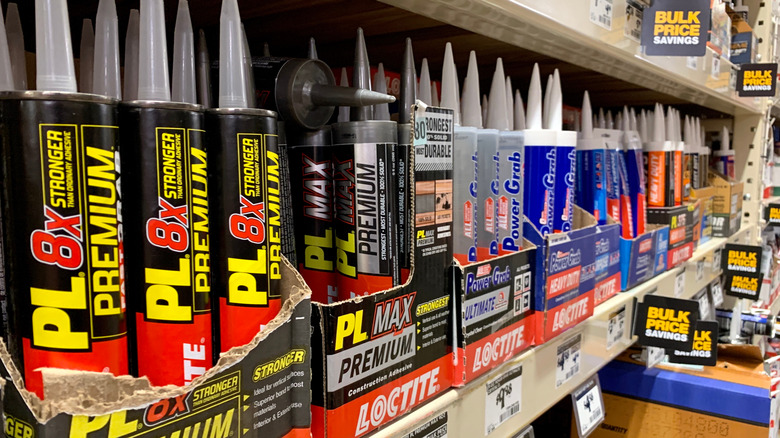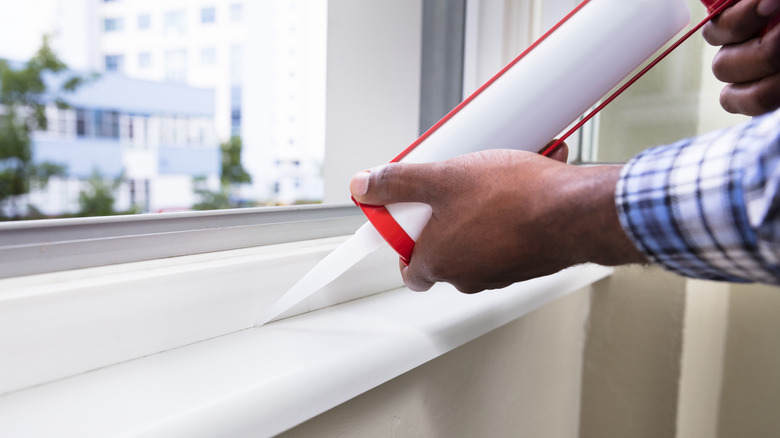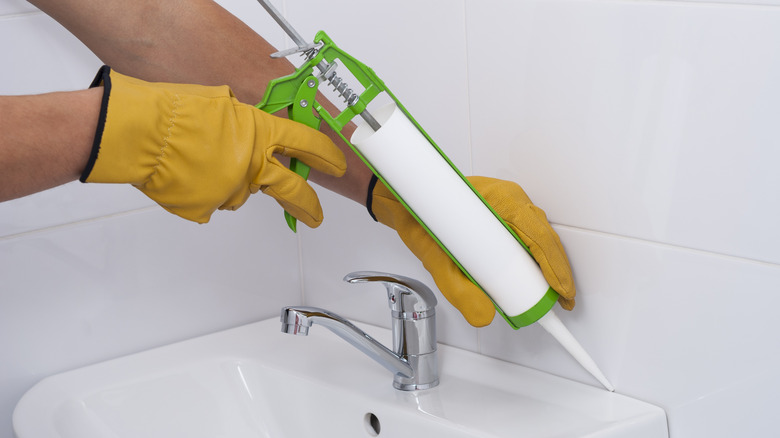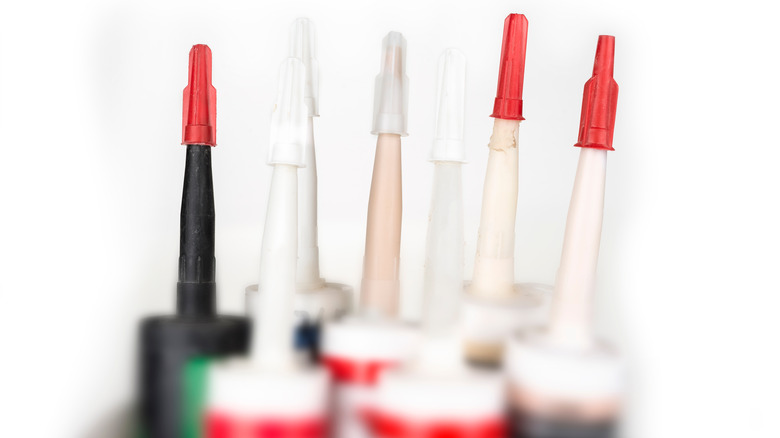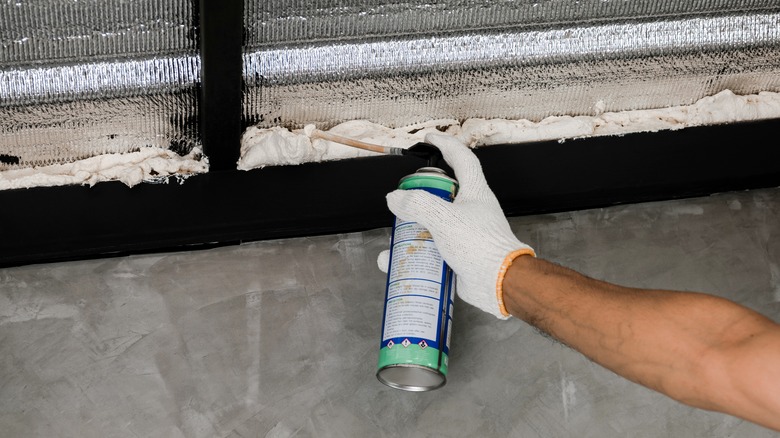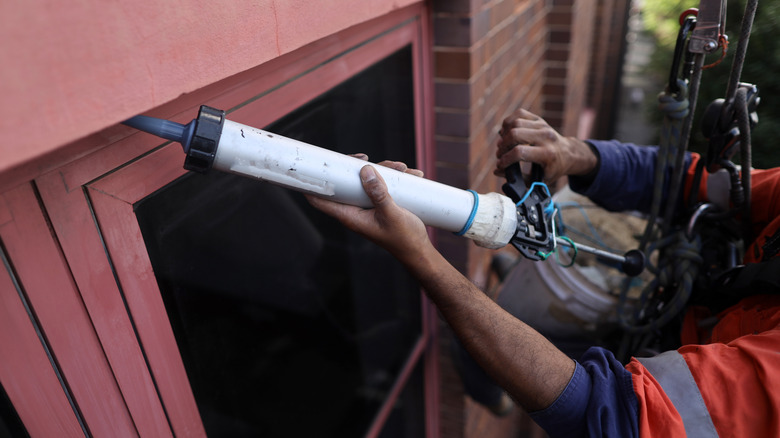How To Choose The Perfect Caulk For Any Job
If there's a draft in your home or you're noticing more bugs sneaking inside, odds are there's a gap in one of your windows or doors that needs to be sealed. Luckily, this is incredibly easy to fix by yourself and requires a quick trip to the caulk and sealant aisle at your local home improvement or hardware store. As Oatey explains, caulk is a non-elastic sealing agent made of various materials for sealing gaps in doors, windows, plumbing installations, securing tiles down, and more.
The hardest part of the simple repairs you use caulk for is choosing the right kind. The caulk and sealant aisle is vast, with many options, all advertising something different. The key feature, though, is the ingredient the caulk is made of. Each formula has a different effect that is ideal for one area of the home. For example, a caulk meant for masonry-related projects wouldn't suit your bathtub. Read on to learn the difference between each caulk type and which is best for your next repair or installation.
Acrylic latex caulk
The most popular and versatile type of caulk is acrylic latex caulks, also frequently referred to as painter's caulk. According to Home Depot, you should use acrylic latex caulk for sealing holes or gaps in drywall, wood (furniture, baseboards, etc.), or masonry-related projects. Acrylic latex caulk is also called painter's caulk because of how well it dries down, allowing it to be easily painted over and seamlessly blend into the background.
Once applied, latex caulk can last as long as 15 years. However, since it is so inexpensive, accessible, and easy to utilize, you can employ it as frequently as you need around the house. Don't use plain acrylic latex caulk for projects involving water, though, warns Waterproof Caulking & Restoration. There are other caulk and sealants formulated to create water-tight seals specifically, but painter's caulk is not one of them. It also should only be used indoors.
Silicone caulk
Another popular and versatile caulk is silicone caulk, which is most commonly used for water-based projects. As Waterproof Caulking & Restoration explains, silicone caulk is an inorganic material that can last as long as 20 years, won't wear down when exposed to fluctuating temperatures, and is water resistant.
Because of this, silicone caulk should be used for any caulk-based projects in utility or laundry rooms, kitchens, and bathrooms. It's also moisture-resistant, so you don't have to worry about mold growth. However, you can get silicone caulk with added fungicide for extra protection. Be careful when working with silicone caulk, though. As Lowe's warns, since it is water resistant, you'll need to have mineral spirits on hand to clean up any errors or messes. It also has a pretty strong odor, so make sure to wear a ventilation mask and air out the room during use. Finally, not all silicone caulks can be painted over.
Siliconized acrylic caulk
For a combination of the best parts of both acrylic latex caulk and silicone caulk, consider siliconized acrylic caulk, which is essentially acrylic latex caulk with added silicone. There are a handful of benefits to this product, namely that it's incredibly versatile. As House Painting Info points out, siliconized acrylic caulk adheres to multiple surfaces and can withstand a wide variety of temperatures. This means it can be used both indoors and outdoors.
Another benefit of siliconized acrylic caulk is that it can be painted over, unlike many pure silicone caulks. Acrylic latex caulk tends to be much easier to apply and use than silicone caulk, but siliconized acrylic caulk is very easy and smooth to lay and dries in just 24 hours, per Oatey. Since it's waterproof, it can be used in any room with high humidity, and it's ideal for use on bathtubs and showers, exterior siding, backsplash tiles, and to seal drafts.
Expandable foam caulk
Home Depot recommends using an expandable foam caulk if you're dealing with an influx of bugs, damping sound, or have other insulation needs. These polyurethane-based caulks have a long, straw-like applicator that easily snakes into a gap and fills it with the expanding foam. It can also be used to repair small cracks in home foundations, though it isn't a cure-all for a crumbling foundation.
Waterproof Caulking & Restoration warns that expandable foam caulk can be challenging to work with since the consistency is a little hard to control through the straw. For this reason, they recommend only using it in smaller areas, like around outlets. It can also fill and seal the gap around exit pipes in your home. Another reason expandable foam caulk is ideal for controlling pest gaps is that once dry, the thick consistency makes it impossible for them to chew or burrow through.
Butyl-rubber caulk
Most of the previously mentioned caulks are either exclusive to interior projects and repairs or are ideally only used indoors. If you need a sturdy, heavy-duty caulk for exterior use only, then you need a butyl-rubber caulk. Be careful when employing this product, though — Home Depot warns it can be a skin and eye irritant, so always wear gloves and goggles when using it. It's also tacky and hard to remove, so wear clothes and shoes you don't mind ruining.
Some projects requiring butyl-rubber caulk include sealing roofing, gutters, roof vents, vinyl siding, aluminum siding, and pipes, per White Lightning. It can also be used on wood, vinyl, rubber, stone, mortar, metal, concrete, and plastic. The heavy-duty mixture can withstand water, fluctuating and extreme temperatures, and moisture without shrinkage. Despite being heavy-duty, it's still quite flexible and can last as long as 12 years (via The Raleigh Paint Contractor).
